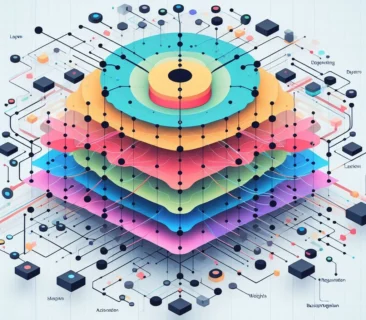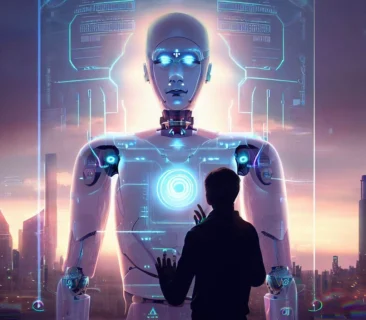Introduction:
In an era where technology evolves at an unprecedented pace, our means of communication are undergoing a revolutionary transformation. Welcome to Nextech Pulse, your compass to the realm of tomorrow’s technologies. In this digital age, the convergence of Artificial Intelligence (AI) and voice recognition has ignited a paradigm shift in the way we interact with machines, unraveling possibilities that were once confined to the realm of science fiction.
As we stand at the crossroads of innovation, our latest exploration takes us deep into the heart of AI-powered voice recognition breakthroughs. This article unveils the intricate dance between AI trends and voice recognition innovations that is reshaping how we communicate, connect, and create. From the seamless harmony of virtual assistants to the empowerment of diverse voices through enhanced accessibility, the tapestry of AI and voice recognition is weaving a narrative of endless potential.
Journey with us through the corridors of evolution as we dissect the dynamic relationship between AI and voice recognition. Embark on a quest to understand the myriad applications spanning industries like healthcare, automotive, and customer service, where AI’s orchestration of voice is orchestrating the symphony of progress. But amid the harmonious melody, questions of security, privacy, and ethical considerations rise like crescendos, demanding our attention.
Beyond the present, we peer into the future, where AI-driven voice recognition takes us on an exhilarating ride. Imagine machines that not only understand our words but also comprehend the nuances of emotions and predict our thoughts. As we navigate these uncharted territories, we’ll also navigate the implications these advancements hold for society.
So, fasten your seatbelts as we embark on this voyage through the dimensions of AI-powered voice recognition breakthroughs. The stage is set, the curtain rises, and the future of communication unfolds before us. Join Nextech Pulse on this enlightening expedition as we decode the symphony of progress, one voice command at a time.
1. AI’s Evolution in Voice Recognition
In the ever-evolving landscape of technology, the evolution of Artificial Intelligence (AI) has been nothing short of remarkable. From deciphering complex data patterns to powering self-driving cars, AI has become the cornerstone of innovation across industries. One of its most remarkable applications has been in the field of voice recognition, reshaping how we interact with machines and each other.
From Clunky to Conversational: A Journey Through Voice Recognition Evolution
Gone are the days of clunky voice commands that left us frustrated and misunderstood. The evolution of AI-driven voice recognition has transformed these interactions into seamless, human-like conversations. Early iterations stumbled over accents, misunderstood context, and struggled with diverse languages. However, with advancements in machine learning algorithms and natural language processing (NLP), the barriers that once hindered effective communication have been shattered.
The Role of Deep Learning and Neural Networks
Deep learning, a subset of machine learning, has been pivotal in propelling voice recognition to new heights. Neural networks, inspired by the human brain’s interconnected neurons, have enabled machines to analyze and interpret the nuances of human speech. These networks can now process vast amounts of data, learn from patterns, and adjust their algorithms to enhance accuracy over time.
Learning Context and Intent
AI-driven voice recognition has moved beyond mere word recognition. Modern systems possess the ability to understand context and intent. This means that when you ask a virtual assistant for the weather, it doesn’t just provide the temperature but also comprehends the location and time frame you’re referring to. This shift from isolated commands to contextual understanding has made interactions more fluid and natural.
From Personal Assistants to Collaborative Companions
Virtual assistants like Siri, Alexa, and Google Assistant have become our daily companions, assisting with tasks ranging from setting reminders to searching for information. AI’s evolution in voice recognition has elevated these virtual entities from mere tools to collaborative companions. They now comprehend user preferences, anticipate needs, and even engage in light banter, enhancing user engagement and satisfaction.
A Glimpse into the Future
As AI continues to learn and adapt, the future promises even more astonishing developments. We’re on the brink of witnessing voice recognition systems that can seamlessly transition between languages, dialects, and accents, fostering global connectivity like never before. Moreover, as AI becomes more emotionally intelligent, machines might discern not only what we say but also how we feel.
In conclusion, AI’s evolution in voice recognition has marked a transformative journey from disjointed commands to harmonious conversations. Through the power of deep learning, neural networks, and contextual understanding, machines have not only become adept at deciphering our words but also at comprehending our intentions. The dawn of collaborative companions and the tantalizing glimpse into a multilingual, emotionally intuitive future speak volumes about the boundless potential of AI in voice recognition. As we venture further into the landscape of technology, it’s certain that the symphony of human-machine interaction will only grow richer and more melodious.
2. Virtual Assistants Redefined
In the age of AI-driven innovations, virtual assistants have emerged as the front-runners, exemplifying the prowess of voice recognition technology. These once-static tools have morphed into dynamic companions that not only understand our words but also anticipate our needs and preferences. Let’s delve into how AI-powered voice recognition has redefined virtual assistants, making them more intuitive and capable than ever before.
Elevating User Experience: The Evolution of Virtual Assistants
Gone are the days when virtual assistants were limited to basic commands. AI’s infusion has elevated their capabilities to understand complex queries, engage in context-aware conversations, and offer personalized solutions. This transformation has turned virtual assistants into indispensable assets for managing daily tasks, from scheduling appointments to making online purchases.
Natural Language Processing (NLP): The Catalyst for Conversational Companions
The driving force behind the redefinition of virtual assistants is Natural Language Processing (NLP). This subfield of AI equips machines with the ability to understand and generate human language in a way that’s both meaningful and contextually relevant. Through machine learning algorithms, virtual assistants can now comprehend not just the words we use, but the underlying semantics, intentions, and emotions behind them.
From Command-Response to Contextual Understanding
Early virtual assistants followed a rigid command-response model. You had to frame your requests in a specific manner for them to comprehend. With AI and NLP, virtual assistants have transitioned to contextual understanding. You can engage in more natural conversations, and the virtual assistant will deduce the context, allowing for dynamic and efficient interactions.
Personalization and Anticipatory Intelligence
AI-driven virtual assistants don’t just respond; they anticipate. By analyzing past interactions and user behaviors, these companions can proactively offer suggestions, reminders, and information tailored to individual preferences. This level of personalization enhances user engagement and streamlines tasks, making virtual assistants an integral part of daily life.
Empowering Multimodal Interactions
Voice recognition innovations have empowered virtual assistants to embrace multimodal interactions. Beyond just voice, they can interpret gestures, understand images, and even process text-based inputs. This versatility opens doors to a more inclusive and diverse user experience, accommodating various communication styles and abilities.
Future Horizons: Where Virtual Assistants Are Heading
The journey of virtual assistants doesn’t halt here; it’s just the beginning. The fusion of AI with augmented reality (AR) and virtual reality (VR) holds the potential to create immersive environments where virtual assistants become true companions in both digital and physical spaces. Imagine a world where you can see, hear, and interact with your assistant as if they were right beside you.
In essence, AI-driven voice recognition has revolutionized virtual assistants, transforming them from scripted tools to intuitive companions. Through NLP, context awareness, and anticipatory intelligence, these digital allies have seamlessly integrated into our lives, enhancing productivity and convenience. As we peer into the future, the convergence of AI, AR, and VR promises to redefine virtual assistants once again, blurring the lines between reality and the digital realm.
3. Enhanced Accessibility
In the realm of technology, accessibility is a cornerstone of progress. The fusion of AI and voice recognition has ushered in a new era of inclusivity, empowering individuals with diverse abilities to interact with technology in unprecedented ways. Let’s explore how AI-powered voice recognition is enhancing accessibility and bridging gaps that once hindered full participation in the digital world.
Beyond Barriers: Redefining Inclusivity through Voice Recognition
For individuals with disabilities, traditional modes of interaction can present significant barriers. AI’s integration with voice recognition technology is changing that paradigm. The ability to control devices, access information, and engage with applications using voice commands empowers those with physical limitations, motor impairments, or visual challenges to navigate the digital landscape with ease.
Voice as an Equalizer: Demolishing Technological Barriers
The keyboard and mouse have long been primary tools for digital communication, inadvertently excluding those who face difficulties in using them. Voice recognition brings a new dimension, transforming spoken language into a universal interface. This democratization of technology dismantles the barriers that once limited participation, granting everyone a voice in the digital age.
Navigating Smart Environments: IoT and Voice Recognition
The Internet of Things (IoT) has woven technology into the fabric of our lives, but for individuals with disabilities, interacting with a myriad of smart devices can be daunting. Voice recognition offers a solution. Through simple voice commands, users can control lights, thermostats, and even security systems, independently managing their environment.
Assistive Applications: Enabling Independence
AI-powered voice recognition is fostering independence like never before. Applications equipped with this technology can help visually impaired individuals read aloud text, identify objects, and even describe surroundings. Similarly, those with mobility challenges can perform tasks like sending messages, making calls, and setting reminders through voice-driven interfaces.
Beyond Words: Embracing Diversity
AI-driven voice recognition isn’t just about understanding words; it’s about embracing diverse forms of communication. Sign language, for instance, can be translated into text or speech, enabling seamless interaction between individuals who communicate using different modalities. This inclusivity goes beyond just language barriers, creating bridges of understanding.
A Call for Ethical Consideration
While the benefits of enhanced accessibility through AI and voice recognition are profound, it’s crucial to address potential pitfalls. Privacy concerns, security vulnerabilities, and unintentional biases must be navigated responsibly. As technology progresses, it’s imperative to ensure that these innovations remain empowering and respectful of individual rights.
A Glimpse of Tomorrow: Expanding Boundaries
The journey of AI-powered voice recognition towards enhanced accessibility is far from over. As technology evolves, so will the capabilities to empower individuals of all abilities. The future holds promises of even more sophisticated applications, ranging from real-time language translation for the deaf to wearable devices that interpret facial expressions for those with cognitive impairments.
In conclusion, AI-powered voice recognition is a beacon of inclusivity, tearing down barriers and opening doors for individuals who were once marginalized in the digital world. Through voice commands, gestures, and the translation of diverse communication modes, technology is becoming a universal bridge to information and interaction. As we move forward, it’s crucial to keep the flame of innovation burning while ensuring that these advancements are accessible, secure, and respectful of every individual’s rights and needs.
4. Natural Language Processing Mastery
In the realm of AI and voice recognition, Natural Language Processing (NLP) stands as a towering achievement, enabling machines to comprehend and respond to human speech with remarkable finesse. This key component has propelled voice recognition technology to new heights, bringing us closer to the elusive goal of human-like interactions with machines. Let’s delve into how NLP mastery has transformed the landscape of voice recognition.
Decoding Human Language: The Power of Natural Language Processing
Natural Language Processing is the bridge that spans the gap between human communication and machine understanding. Through complex algorithms, linguistic patterns, and semantic analysis, NLP empowers machines to not only grasp the words we speak but also discern the context, intent, and emotional nuances behind them.
Semantic Understanding: Going Beyond Literal Interpretation
One of the breakthroughs brought about by NLP is semantic understanding. This allows machines to interpret language in context, understanding the subtle nuances that come with human speech. For instance, a request like “Find me a cozy café nearby” isn’t just about locating a café; it’s about identifying an environment that aligns with the user’s preferences.
Conversational Context: A Leap Towards Human-Like Interaction
In the realm of voice recognition, conversations are rarely isolated exchanges. They’re threads that weave through a tapestry of context. NLP empowers machines to maintain this context, ensuring that interactions flow naturally. Virtual assistants can now remember previous questions, adapt responses, and engage in sustained dialogues—a hallmark of human-like conversation.
Handling Ambiguity and Polysemy
Human language is rife with ambiguity and polysemy—words with multiple meanings. NLP systems tackle this linguistic complexity by relying on contextual cues to determine the intended meaning. This skill is crucial for accurately deciphering user intent and ensuring that responses align with the conversation’s trajectory.
Multilingual Mastery: Breaking Language Barriers
NLP has unlocked the door to multilingual communication. Modern voice recognition systems can understand and respond in various languages, broadening accessibility and fostering global connectivity. This expansion goes beyond translation; it involves understanding idioms, cultural references, and colloquial expressions that enrich human speech.
Future Frontiers: Emotional Context and Sentiment Analysis
The next frontier in NLP is the integration of emotional context and sentiment analysis. As AI gains the ability to perceive and respond to human emotions, interactions will take on a new dimension. Imagine a virtual assistant that can gauge your mood and tailor responses accordingly, offering empathy and support in real time.
In essence, NLP mastery has propelled voice recognition to the cusp of a remarkable feat: machines that understand not just the mechanics of language but also its intricacies, emotions, and intentions. Through semantic understanding, conversational context, and multilingual prowess, NLP brings us closer to the age-old dream of machines comprehending human language in all its richness. As we move forward, the journey towards emotional context understanding promises to deepen the bond between humans and machines, creating interactions that resonate on a profoundly human level.
Closing:
As we bring our expedition through the realm of AI-powered voice recognition to a close, it’s clear that we’re standing on the cusp of an exhilarating new era. The symphony of progress composed by the harmonious blend of AI and voice recognition is reverberating across industries, transforming the way we interact, work, and live.
From the inception of virtual assistants that comprehend our every word to the democratization of technology through enhanced accessibility, the future has never been so promising. However, amidst the grandeur of innovation, we must not overlook the ethical and security considerations that accompany this brave new world.
As we gaze into the horizon of what’s to come, the possibilities are tantalizing. The marriage of AI and voice recognition holds the potential to paint a canvas where machines understand not just the words we speak, but also the emotions we convey. Yet, this future isn’t without its complexities, urging us to ponder the paths we tread.
In this juncture of transformation, we at Nextech Pulse are committed to guiding you through the evolving landscapes of technology. With each innovation, breakthrough, and trend, we’ll be your compass, illuminating the way forward.
Thank you for joining us on this illuminating journey. As the curtains fall on this exploration, remember that the symphony of AI-powered voice recognition continues to crescendo, with new notes waiting to be struck and melodies waiting to be composed. Stay curious, stay engaged, and stay tuned for the unfolding chapters of tomorrow’s technologies.
Until our next encounter on the digital frontier,
The Nextech Pulse Team
References:
1. Clark, L. (2020). Voice Recognition Technology and Its Applications in Education. EdTech Magazine. Link
2. Gao, Q., Huang, T., Dai, L., & Wang, X. (2021). Voice-Driven E-commerce: How Does Voice Recognition Affect Online Shopping? Journal of Retailing and Consumer Services, 63, 102741.
3. Gurz, L., & Asim, M. (2019). A Comparative Study of the Accessibility of Voice Assistants for Visually Impaired Users. Proceedings of the 2019 CHI Conference on Human Factors in Computing Systems, Paper No. 272.
4. Kopparapu, S. K., Reddy, K. K., & Namani, K. (2017). A Review on Natural Language Processing Techniques in Human–Computer Interaction for Customer Support Systems. International Journal of Computer Science and Information Security, 15(2), 109-114.
5. Oh, K. J., & Kim, H. (2019). A Study on the Influence of Voice Recognition Service on Driver’s Safety. Journal of Highway Engineering, 24(7), 130-137.




